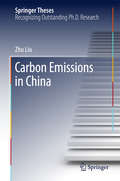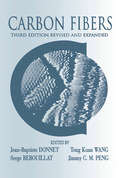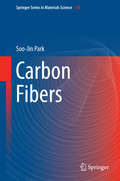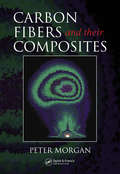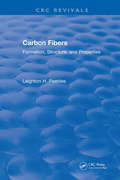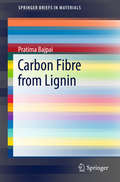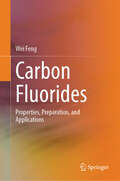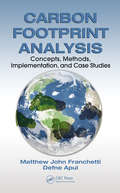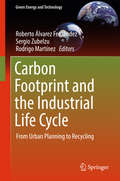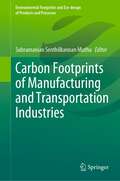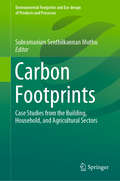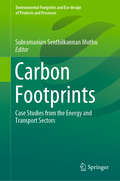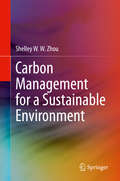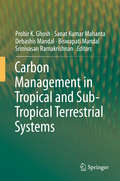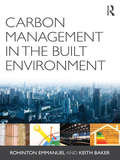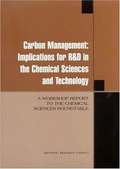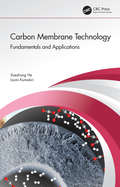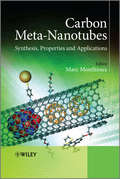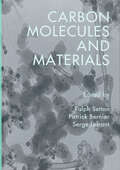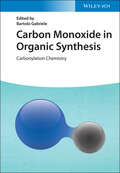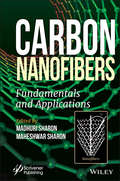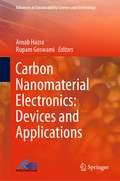- Table View
- List View
Carbon Emissions in China (Springer Theses)
by Zhu LiuThis study analyzes the spatial-temporal pattern and processes of China's energy-related carbon emissions. Based on extensive quantitative analysis, it outlines the character and trajectory of China's energy-related carbon emissions during the period 1995-2010, examining the distribution pattern of China's carbon emissions from regional and sectoral perspectives and revealing the driving factors of China's soaring emission increase. Further, the book investigates the supply chain carbon emissions (the carbon footprints) of China's industrial sectors. Population growth, the fossil energy supply, and anthropogenic climate change are the most serious challenges currently facing humankind. China is the world's largest developing country, top primary energy consumer and carbon emitter. Achieving both economic growth and environmental conservation is the country's twofold challenge. Understanding the status, features and driving forces of China's energy-related carbon emissions is a critical aspect of attaining global sustainability. This work, for the first time, presents both key findings on and a systematic evaluation of China's carbon emissions from energy consumption. The results have important implications for global carbon budgets and burden-sharing with regard to climate change mitigation. The book will be of great interest to readers around the world, as it addresses a topic of truly global significance.
Carbon Fibers
by Jean-Baptiste Donnet Roop Chand Bansal"Third Edition offers the latest information on the structural, surface, mechanical, electronic, thermal, and magnetic properties of carbon fibers as well as their manufacture and industrial applications from many of the world's most distinguished specialists in the field. "
Carbon Fibers (Springer Series in Materials Science #210)
by Soo-Jin ParkThis book contains eight chapters that discuss the manufacturing methods, surface treatment, composite interfaces, microstructure-property relationships with underlying fundamental physical and mechanical principles, and applications of carbon fibers and their composites. Recently, carbon-based materials have received much attention for their many potential applications. The carbon fibers are very strong, stiff, and lightweight, enabling the carbon materials to deliver improved performance in several applications such as aerospace, sports, automotive, wind energy, oil and gas, infrastructure, defense, and semiconductors. However, the use of carbon fibers in cost-sensitive, high-volume industrial applications is limited because of their relatively high costs. However, its production is expected to increase because of its widespread use in high-volume industrial applications; therefore, the methods used for manufacturing carbon fibers and carbon-fiber-reinforced composites and their structures and characteristics need to be investigated.
Carbon Fibers and Their Composites (Materials Engineering)
by Peter MorganMost literature pertaining to carbon fibers is of a theoretical nature. Carbon Fibers and their Composites offers a comprehensive look at the specific manufacturing of carbon fibers and graphite fibers into the growing surge of diverse applications that include flameproof materials, protective coatings, biomedical and prosthetics application
Carbon Fibers: Formation, Structure, and Properties
by Leighton H. PeeblesCarbon Fibers presents an up-to-date review of the progress pertaining to the formation of carbon fibers from rayon, acrylic, and pitch precursors. The book emphasizes the preparation, characterization, and properties of commercial materials. It also considers the compressive properties of carbon fibers, the lack of correlation between surface characterization and fiber-matrix interactions, and the discrepancy between surface composition as determined by XPS and the reaction of surface groups with chemical reagents. Other topics discussed include:
Carbon Fibre from Lignin (SpringerBriefs in Materials)
by Pratima BajpaiThis book presents detailed information on the production and properties of carbon fibers derived from lignin precursors. Focusing on future directions in the carbon fiber industry, it also introduces a novel process for obtaining high-purity lignin, a key aspect in the manufacture of high-quality carbon fiber. Carbon fiber is currently the most preferred lightweight manufacturing material and is rapidly becoming the material of choice for manufacturers around the world. Although more than 80% of commercial carbon fiber is estimated to use PAN (polyacrylonitrile) as a precursor, carbon fiber manufactured from PAN is expensive and therefore its application is limited to high-performance structural materials. Lignin is the second most abundant biopolymer in nature after cellulose and offers a carbon-rich, renewable resource. As a byproduct of the pulp and paper industry and the production of cellulosic ethanol, lignin is also available at low cost, making it an economically attractive alternative to PAN for the production of carbon fibers, as highlighted in this book. The information presented will be of interest to all those involved in the investigation of carbon fiber materials, carbon fiber manufacturers and carbon fiber users.
Carbon Fluorides: Properties, Preparation, and Applications
by Wei FengThis book offers a comprehensive perspective on carbon fluorides, covering detailed descriptions of the structure, properties, preparation, and applications of carbon fluorides, from basic knowledge to the latest research developments. It provides readers with a clear and in-depth analysis of carbon fluorides. This book first describes the structural properties of carbon fluorides, such as the formation of different types of C-F bonds, F/C ratio, and the impact of F atom distribution on material properties. The introduction of F atoms results in unique properties of carbon fluorides in terms of optics, electronics, thermal properties, and mechanical strength, distinguishing them from carbon materials. This book also introduces various carbon fluoride materials prepared from various carbon material precursors currently under research, such as fluorinated graphene, fluorinated carbon nanotubes, fluorinated graphite, and fluorinated fullerenes. The detailed description of the research and applications of carbon fluorides in batteries and other areas is provided. This book is suitable for professionals and academic researchers and also serves as a self-study reference for beginners interested in this field. The author of this book has over a decade of experience and expertise in carbon fluorides research, providing readers with a rich and comprehensive book in this field.
Carbon Footprint Analysis: Concepts, Methods, Implementation, and Case Studies (Systems Innovation Book Series)
by Matthew John Franchetti Defne ApulThe negative impacts of carbon emissions from human activities continue to dramatically reshape the environmental, political, and social landscape. These impacts coupled with cap and trade schemes iterate the importance and need to properly measure and reduce greenhouse gas emissions. Carbon Footprint Analysis: Concepts, Methods, Implementation, an
Carbon Footprint and the Industrial Life Cycle: From Urban Planning to Recycling (Green Energy and Technology)
by Sergio Zubelzu Roberto Álvarez Fernández Rodrigo MartínezThis book analyzes the relationship between large-scale industrial activity and the carbon footprint, and provides a theoretical framework and tools to calculate the carbon footprint of industrial activities at every stage of their life cycles, including urban-planning master plans, recycling activities, project and building stages as well as managing and manufacturing. Discussing the main preventative and corrective measures that can be utilized, it includes case studies, reports on technological developments and examples of successful policies to provide inspiration to readers. This book collects the contributions of authors from four continents, in order to analyze from as many as possible points of view and using many different approaches, the problem of sustainability in today's globalized world.
Carbon Footprints of Manufacturing and Transportation Industries (Environmental Footprints and Eco-design of Products and Processes)
by Subramanian Senthilkannan MuthuThis book presents carbon footprint calculation and mitigation in the manufacturing and transportation sectors. Warning effects of global warming from every sector is of phenomenal importance at this moment and sector wise assessment and remediation are the key factors to mitigate the vulnerable green house gas emissions. This volume with its six chapters deals with the carbon footprint of manufacturing and transportation sectors.
Carbon Footprints: Case Studies from the Building, Household, and Agricultural Sectors (Environmental Footprints and Eco-design of Products and Processes)
by Subramanian Senthilkannan MuthuThis book addresses carbon footprint calculation and mitigation in various industrial sectors. There are numerous sectors whose carbon footprints need to be calculated, and effective ways to mitigate the greenhouse-gas emissions from these sectors need to be found. This book highlights the carbon sequestration potential of the Western Ghats ecosystems, the carbon footprint of Spanish households and residential buildings, and agricultural products in Canada; it also includes a case study on urban carbon footprints.
Carbon Footprints: Case Studies from the Energy and Transport Sectors (Environmental Footprints and Eco-design of Products and Processes)
by Subramanian Senthilkannan MuthuThis book presents revealing case studies on carbon footprint calculation and mitigation in various industrial sectors. There are numerous sectors whose carbon footprints need to be calculated, and effective ways to mitigate the greenhouse-gas emissions from these sectors need to be found. Using representative case studies, this book highlights the carbon footprint of national power generation systems, crude glycerol production plants and the Brazilian highway network system, as well as the integration of renewable energy sources in expansion planning, so as to promote and implement power system decarbonization.
Carbon Labeling Practice: From the Perspective of Stakeholder’s Interaction
by Rui Zhao Yong GengThis book focuses on the behavioral interactions among possible stakeholders in carbon labeling practice, brings the attentions of stakeholders’ interests to explore the opportunities, and challenges related to carbon labeling practice, thus to provide insight into low-carbon consumption and production. It is essential reading for students, researchers, and policy makers as well as those with a wider interest in environmental science and sustainable development.
Carbon Management for a Sustainable Environment
by Shelley W. ZhouThis textbook presents students with a systematic approach for the quantification and management of greenhouse gas emissions (GHG) and provides best practices for optimal carbon management and quantification. The book begins with an overview of climate change basics and goes on to discuss carbon footprint measurements, carbon management concepts, and concludes by presenting carbon reduction solutions with applications for green buildings, smart transportation, waste management, and carbon trading and offsetting. The author provides practical examples and carbon management models that support innovative reduction solutions and presents a roadmap for the implementation and development of carbon management strategies, making it a useful resource for both upper undergraduate and graduate students as well as practitioners seeking a comprehensive framework to conduct carbon management.
Carbon Management in Tropical and Sub-Tropical Terrestrial Systems
by Probir K. Ghosh Sanat Kumar Mahanta Debashis Mandal Biswapati Mandal Srinivasan RamakrishnanSoil organic carbon (SOC), a key component of the global carbon (C) pool, plays an important role in C cycling, regulating climate, water supplies and biodiversity, and therefore in providing the ecosystem services that are essential to human well-being. Most agricultural soils in temperate regions have now lost as much as 60% of their SOC, and as much as 75% in tropical regions, due to conversion from natural ecosystems to agricultural uses and mainly due to continuous soil degradation. Sequestering C can help to offset C emissions from fossil fuel combustion and other C-emitting activities, while also enhancing soil quality and long-term agronomic productivity. However, developing effective policies for creating terrestrial C sinks is a serious challenge in tropical and subtropical soils, due to the high average annual temperatures in these regions. It can be accomplished by implementing improved land management practices that add substantial amounts of biomass to soil, cause minimal soil disturbance, conserve soil and water, improve soil structure, and enhance soil fauna activity. Continuous no-till crop production is arguably the best example. These soils need technically sound and economically feasible strategies to sustainably enhance their SOC pools. Hence, this book provides comprehensive information on SOC and its management in different land-use systems, with a focus on preserving soils and their ecosystem services. The only book of its kind, it offers a valuable asset for students, researchers, policymakers and other stakeholders involved in the sustainable development and management of natural resources at the global level.
Carbon Management in the Built Environment
by Keith Baker Rohinton EmmanuelThree broad sectors of the economy are generally recognized as key to a low carbon future: energy, construction and transportation. Of these, carbon management in the built environment remains the least well-studied. This much-needed book brings together the latest developments in the field of climate change science, building design, materials science, energy and policy in a form readily accessible to both students of the built environment and practitioners. Although several books exist in the broad area of carbon management, this is the first to bring together carbon management technology, technique and policy as they apply to the building sector. Clear and succinct sections on the overarching principles, policies, approaches and technologies are combined with case studies and more in-depth coverage of the most relevant topics. It explains how to produce a simple carbon footprint calculation, while also being an informative guide for those developing or implementing more advanced approaches. This easy to read book is the ideal primer for anyone needing to get to grips with carbon management in the built environment.
Carbon Management: A WORKSHOP REPORT TO THE CHEMICAL SCIENCES ROUNDTABLE
by Chemical Sciences RoundtableA report on Carbon Management
Carbon Membrane Technology: Fundamentals and Applications
by Xuezhong He Izumi KumakiriCarbon membranes have great advantages of strong mechanical strength and high chemical stabilities, as well as high separation performance to reach the industrial attractive region. Further improvement on membrane performance can potentially offset the relatively high production cost compared to polymeric membranes. However, there are still some challenges related to fabrication of asymmetric carbon membranes, the controlling of structure and pore-size and module up-scaling for commercial application. The aim of this book is to provide the fundamentals on carbon membrane materials for the young researchers and engineers to develop frontier membrane materials for energy efficient separation process. This book describes the status and perspectives of both self-supported and supported carbon membranes from fundamentals to applications. The key steps on the development of high performance carbon membranes including precursor selection, tuning carbon membrane structure and regeneration are discussed. In the end, different potential applications both in gas and liquids separation are well described, and the future directions for carbon membrane development were pointed out. To this end, membrane science and engineering are set to play crucial roles as enabling technologies to provide energy efficient and cost-effective future solutions for energy and environment related processes. Based on this approach the research projects which are trying to find attractive carbon materials in our days are many. The published papers, per year, in the topic of carbon membranes, especially for biogas upgrading, natural gas sweetening and hydrogen purification, are numerous with very high impact. However, only few are the books which include relevant to the topic of carbon membrane technology. This book offers the condensed and interdisciplinary knowledge on carbon membranes, and provides the opportunity to the scientists who are working in the field of carbon membrane technology for gas and liquid separations to present, share, and discuss their contributions within the membrane community.
Carbon Meta-Nanotubes
by Marc MonthiouxMeta-Nanotubes are a new generation of carbon nanotubes (CNTs) which result from the chemical transformation of regular CNTs and their subsequent combination with foreign materials (atoms, molecules, chemical groups, nanocrystals) by various ways such as functionalisation, doping, filling, and substitution. These new nanomaterials exhibit enhanced or new properties, such as reactivity, solubility, and magnetism, which pristine CNTs do not possess. Their many applications include electronic and optoelectronic devices, chemical and biosensors, solar cells, drug delivery, and reinforced glasses and ceramics.Carbon Meta-Nanotubes: Synthesis, Properties and Applications discusses these third generation carbon nanotubes and the unique characteristics they possess. Beginning with a general overview of the subject, this book covers the five main categories of meta-nanotubes, namely:Doped Carbon Nanotubes Functionalised Carbon Nanotubes Decorated or Coated Carbon Nanotubes Filled Carbon Nanotubes Heterogeneous Nanotubes Providing unparalleled coverage of these third generation or meta-nanotubes, and possibilities for future development, this book is essential for anyone working on carbon nanotubes.
Carbon Molecules and Materials
by Patrick Bernier Serge Lefrant Ralph SettonThe unexpected recent discovery and synthesis of a new form of elemental carbon has initiated an abundance of papers on all aspects of the chemistry and physics of the carbon family. Carbon Molecules and Materials takes stock of the current understanding of these various solid forms and, more particularly, of the diamond, graphite and fullerenes. A
Carbon Monoxide in Organic Synthesis: Carbonylation Chemistry
by Bartolo GabrieleA thoroughly up-to-date overview of carbonylation reactions in the presence of carbon monoxide In Carbon Monoxide in Organic Synthesis: Carbonylation Chemistry, expert researcher and chemist Bartolo Gabriele delivers a robust summary of the most central advances in the field of carbonylation reactions in the presence of carbon monoxide. Beginning with a brief introduction on the importance of carbon monoxide as a building block in modern organic synthesis, the author goes on to describe metal-catalyzed carbonylations utilizing iron, cobalt, nickel, copper, and manganese. Descriptions of palladium, ruthenium, and rhodium-catalyzed reactions follow, as do discussions of metal-free carbonylation processes. The book is organized by metal to make the book useful as a guide for researchers from both academia and industry whose work touches on the direct synthesis of carbonyl compounds, carboxylic acid derivatives, and heterocycles. It aims to stimulate further discoveries in this rapidly developing field. Readers will also enjoy: A thorough introduction to carbonylations promoted by first row transition metal catalysts, including cobalt-catalyzed and nickel-catalyzed carbonylations An exploration of carbonylations promoted by second row transition metal catalysts, including ruthenium-, rhodium-, palladium(0)-, and palladium(II)-catalyzed carbonylations Practical discussions of miscellaneous carbonylation reactions, including carbonylations promoted by third row transition metal catalysts and metal-free carbonylation processes Perfect for catalytic and organic chemists, Carbon Monoxide in Organic Synthesis: Carbonylation Chemistry is also an indispensable resource for chemists working with organometallics and industrial chemists seeking a summary of important processes used to synthesize value-added products.
Carbon Nanofiber Reinforced Polymer Composites (SpringerBriefs in Materials)
by Nikhil Gupta Ronald L. PovedaThis book presents an extensive review of literature on the properties of carbon nanofibers (CNF) reinforced polymer composites in conjunction with advances in the production and properties of CNFs. It further provides readers a view into the development of lightweight composites whose properties are tailored and enhanced with micro- and nano-reinforcement, along with results from data comparisons from several published investigations.
Carbon Nanofibers: Fundamentals and Applications (Advances in Nanotechnology and Applications)
by Maheshwar Sharon Madhuri SharonThis book covers the fundamentals and applications of Carbon Nanofiber (CNF). In the first section, the initial chapter on the fundamentals of CNF is by Professor Maheshwar Sharon, the recognized “Father of Carbon Nanotechnology in India”, which powerfully provides a succinct overview of CNFs. This is followed by a chapter on biogenics that have produced unique morphologies of CNF that makes them suitable to various applications. This is followed by a chapter that mainly focuses on nanocomposites, especially those involving nanocomposites of CNF. The role of nanocatalysts and composites in promoting and enhancing the synthesis and application of CNF is then covered, followed by an important chapter on the characterization of CNF. The second section of the book encompasses the various applications of CNF, such as its use as a possible superconductor to adsorb and store hydrogen, and as a microwave absorber. The application of CNF for environmental concerns is also detailed by assessing its usefulness in dye and heavy metal removal from polluted water. The applications that are addressed include lithium-ion battery, solar cell, antenna, cosmetics, usefulness in regenerative medicine, as well as various aspects of agrotechnology.
Carbon Nanomaterial Electronics: Devices and Applications (Advances in Sustainability Science and Technology)
by Arnab Hazra Rupam GoswamiThis book brings together selective and specific chapters on nanoscale carbon and applications, thus making it unique due to its thematic content. It provides access to the contemporary developments in carbon nanomaterial research in electronic applications. Written by professionals with thorough expertise in similar broad area, the book is intended to address multiple aspects of carbon research in a single compiled edition. It targets professors, scientists and researchers belonging to the areas of physics, chemistry, engineering, biology and medicine, and working on theory, experiment and applications of carbon nanomaterials.
Carbon Nanomaterials (Advanced Materials and Technologies)
by Yury Gogotsi Volker PresserThis book provides information on synthesis, properties, and applications of carbon nanomaterials. With novel materials, such as graphene (atomically flat carbon) or carbon onions (carbon nanospheres), the family of carbon nanomaterials is rapidly growing. This book provides a state-of-the-art overview and in-depth analysis of the most important ca
